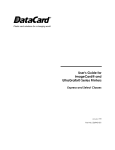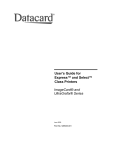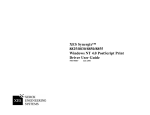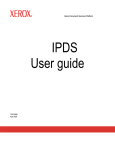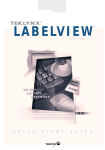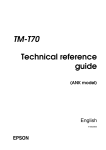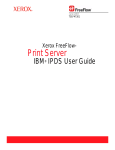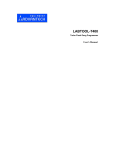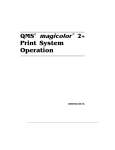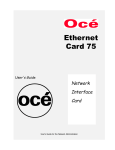Download DataCard select series Specifications
Transcript
Printer Driver for the Datacard 150i, 28x, and 450 Series Printers on Windows® 95 and 98 Installation and Technical Reference Manual November 2001 Part No. 526887-001, Rev B Revision Log Printer Driver for the Datacard Printers on Windows® 95 and 98 Installation and Technical Reference Manual Revision Date Affected Pages Description of Changes A May 1998 All New Release B December 2001 All Update for new company information and Windows 98. Liability Statement This Datacard product has been built to the high standards of DataCard Corporation. Please note and heed the WARNING and CAUTION labels that have been placed on the equipment for your safety. Please do not attempt to operate or repair this equipment without adequate training. Any use, operation or repair in contravention of this document is at your own risk. By acceptance of this system you hereby assume all liability consequent to your use or misuse of this equipment. DataCard Corporation assumes no liability for incidental, special or consequential damage of any kind. Equipment specifications, applications and options are subject to change at the sole discretion of DataCard Corporation without notice. Proprietary Notice All drawings and information herein is the property of DataCard Corporation. All unauthorized use and reproduction is prohibited. Acknowledgments Datacard is a registered trademark and QuikWorks is a trademark of DataCard Corporation. Microsoft and Windows are registered trademarks of Microsoft Corporation. © 1998, 2001 DataCard Corporation. All rights reserved. Printed in the United States of America. Datacard Group 11111 Bren Road West Minnetonka, MN 55343-9015 952.933.1223 Fax: 952.933.7971 www.datacard.com ii Table of Contents Introduction _______________________________________________________________________ 1 What’s in this Manual___________________________________________________________________1 Related Documents ____________________________________________________________________2 System Requirements___________________________________________________________________3 Printer Driver Limitations ________________________________________________________________4 Embossing Limitations __________________________________________________________________4 Installing the Printer Driver__________________________________________________________ 5 Selecting Embossing and Indent Fonts _________________________________________________ 10 Setting 150i Printer Configuration Options ______________________________________________ 12 Setting 28x Printer Configuration Options ______________________________________________ 13 Setting Customer Engineer Configuration Options__________________________________ 13 Setting Supervisor Configuration Options __________________________________________ 14 Setting 450 Printer Configuration Options ______________________________________________ 15 Disabling Auto Remake __________________________________________________________ 15 Setting Communication Parameters ______________________________________________ 15 Printer Fonts ______________________________________________________________________ 17 Embossing and Indent Type___________________________________________________________ 19 Magnetic Stripe Encoding ____________________________________________________________ 20 Translating Characters _______________________________________________________________ 21 Changing a Character Translation ________________________________________________ 23 Deleting a Translated Character __________________________________________________ 24 Printing in a Windows Environment_________________________________________________ 25 Adding CPX Ports ____________________________________________________________________ 25 Restoring Default Spool Settings _______________________________________________________ 28 Troubleshooting __________________________________________________________________ 29 Why do I get an error using embossed fonts? __________________________________________ 29 Embossed fonts do not print as they appear on the screen. _____________________________ 29 Why don't embossed fonts appear in the font menu? __________________________________ 29 Why don't magnetic stripe fonts appear in the font menu? _____________________________ 30 Why do I get time-out errors? _________________________________________________________ 30 Initial setup problems printing Graphics, Embossing or Magnetic Stripe __________________ 31 How do I check the version of the printer driver? _______________________________________ 31 My Word 97 document doesn’t print. __________________________________________________ 31 Multiple copies of Word 6 documents don't print. ______________________________________ 31 Index ____________________________________________________________________________ 33 iii List of Tables Table 1: Supported Printer Capabilities................................................................................................ 1 Table 2: Text Fonts ................................................................................................................................. 18 Table 3: Embossing and Indent Type by Printer ............................................................................... 19 Table 4: Magnetic Stripe Tracks ........................................................................................................... 20 iv Introduction The Datacard Printer Drivers for Windows® 95 and 98 provide users with the ability to print from those Microsoft® Windows operating systems to the Datacard 150i, 280, 285, and 450 Series card printers. The capabilities of these printers are listed in Table 1. Table 1: Supported Printer Capabilities Printer Capabilities 150i Emboss Indent Encode magnetic stripes Topping 280 Emboss Indent Encode magnetic stripes Print graphics Topping 285 Encode magnetic stripes Print graphics 450 Emboss Indent Encode magnetic stripes Topping This driver allows for rotation of both barcodes and printed text but not for rotation of embossed text. What’s in this Manual This manual contains the following information: Introduction. This chapter provides information about system requirements and limitations. Installing the Printer Driver. This chapter provides installation information and procedures for both the printer driver and the printer. Printer Fonts. This chapter includes information about fonts that are available using the printer driver for Windows 95 and 98. Windows 95 and 98 Printer Driver Installation and Technical Reference 1 Printing in a Windows Environment. This chapter tells how to get information and procedures for pausing, resuming, and deleting print jobs. Troubleshooting. This chapter includes information and procedures for solving printing problems. Related Documents If you need additional information about the printer your system uses, refer to one of the documents listed below: Manual 2 Manual Part Number CD-ROM Library Part Number Datacard 150i Card Personalization System CPX Protocol/Setup Manual 526637-001 539170-001 Datacard 150i Card Personalization System Administrator’s Guide 526638-001 280/285 Card Personalization System CRT Operator’s Manual 539017-001 280/285 Card Personalization System Keyboard Option Operator’s Manual 539018-001 280/285 Card Personalization System Maintenance Manual 539019-001 Datacard CPX Communications Protocol Manual 526473-001 28x Magnetic Stripe Option Installation and Technical Reference Manual 526583-001 Datacard 450 Operator’s Guide 526141-001 539039-001 NA Windows 95 and 98 Printer Driver Installation and Technical Reference System Requirements The minimum system requirements for installing and using the printer driver for Windows 95 or 98 are: · Microsoft Windows 95 or 98 · An computer that meets the Windows minimum requirements · One of the following: · A 150i printer with the following firmware: Mainboard: · · 556228-501 Rev. A or above A 2xx printer with the following firmware: Mainboard: 596006-501 Rev. H or above Graphics: 596199-50x Rev. A or above A 450 printer with the following firmware: Mainboard: 590752-501 Rev. D or above Refer to the operator’s manual for procedures to determine the printer’s firmware level. Windows 95 and 98 Printer Driver Installation and Technical Reference 3 Printer Driver Limitations The Datacard printer driver for Windows 95 or 98 does not support: · Two-sided badge printing using the Datacard QuikWorks software · Encapsulated postscript (.eps) files · Microsoft Windows 3.1 and NT (see separate driver for Windows NT and 2000) · NTT (or J) encoding · Smart card personalization · Barcode generation: your Windows application must generate the barcode and pass it to the driver for printing · “Indent” fonts do not display in WYSIWYG (what-you-see-is-what-you-get) · Encryption capability as required by Visa · The 150i password for the production of major brands of financial cards (Visa, MasterCard, etc.) · Any magnetic stripe encoding schemes other than IATA, ABA, or TTS · Network printing: because of the complex nature of networking, Datacard does not provide Help Desk technical support for the printer driver in networked applications Embossing Limitations Cards pass through the embosser in landscape orientation and the embossing wheels print characters horizontally. Therefore, embossing must be limited to landscape orientation. 4 Windows 95 and 98 Printer Driver Installation and Technical Reference Installing the Printer Driver The Datacard printer driver for Windows 95 or 98 creates CPX ports. CPX ports are virtual ports that use your existing COM ports to communicate with your Datacard printer. No additional hardware is needed. Setting up an additional port in this way tells Windows to use a software component (called a Port Monitor) for printing to your Datacard printer. 1. From the Windows Start button, choose Settings and then Printers. The Printers dialog box appears. 2. Double-click the Add Printer icon. The Add Printer Wizard dialog box appears. 3. Click the Next button. 4. If the computer is on a network, the following dialog box appears. Select Local printer and then click the Next button. 5. Click the Have Disk button on the next window. Windows 95 and 98 Printer Driver Installation and Technical Reference 5 6. Insert the driver disk or CD into the appropriate drive on your computer. Enter the drive identifier, and then click the OK button. 7. Select the description of your Datacard printer from the Printers list and click the Next button. After several seconds, the driver files will be on your system. You must now configure the driver so it knows which port the printer is connected to. 8. 6 Click the Add Port button. Windows 95 and 98 Printer Driver Installation and Technical Reference The Port Name dialog box appears. 9. Type the name of the CPX Port, and then click OK. The CPXx: dialog box appears. 10. Select the baud rate appropriate for your printer. Baud rates set at the factory are: Printer Default Baud Rate 150i 9600 280 and 285 9600 450 19200 Recommended 57600; 19200 if less than a Pentium Windows 95 and 98 Printer Driver Installation and Technical Reference 7 If you select Confirmation for each data block processed, the operator must acknowledge the following message before the printer will continue to the next record. Card-by-card confirmation will reduce throughput. If you select Cache bitmaps in printer memory, the speed of printing can increase significantly when you use Printer type fonts and print the same bitmap (for example, a logo) on several consecutive cards. Other settings are optional. Datacard recommends that only authorized Datacard service representatives alter the remaining settings. 11. Click the OK button. 12. Click the Next button. 13. If you want, type a user friendly name for the printer. In most cases, the default name is sufficient. 8 Windows 95 and 98 Printer Driver Installation and Technical Reference 14. Select whether you want Windows to use your Datacard printer as the default printer. In most cases you should select No. 15. Click the Finish button. Windows completes the installation of your printer. Go on to the next procedure, Selecting Embossing and Indent Fonts. Windows 95 and 98 Printer Driver Installation and Technical Reference 9 Selecting Embossing and Indent Fonts The information that follows explains how to identify to your Windows 95 application program which fonts are resident in your Datacard printer and how to complete the software settings. For a complete explanation of printer fonts, see Printer Fonts. Use the following procedure to select the printer fonts and complete the software settings 1. In the Printers window, select your Datacard printer. Then from the File menu, select Properties. The Properties dialog box for your printer appears. 2. Click the Fonts tab. From the list of fonts available for your printer, select those that are actually installed in your printer. You may select up to five fonts. 3. 10 For all printers, select the Paper tab. Windows 95 and 98 Printer Driver Installation and Technical Reference 4. For the 280, 285, and 450 printers, in the Page size area select the card size you are using. The printer driver refers to the card size as the paper size. Select a logical page size to restrict the printing and embossing to legal areas. If your Windows application does not use page sizes, you must manually position your information in the allowable print area. Be sure to allow a margin of at least 0.200 inch to the centerline of text for normal text, and a top margin of 0.35 inch for embossing fonts. The printer drivers for Windows 95 and 98 support either CR50 or CR80. Your printer is factory set to support one or the other. (The 150i supports only CR80.) 5. For all printers, in the Orientation area, select Landscape. Both orientations allow graphics and embossing. However, cards pass through the embosser in landscape orientation and the embossing wheels print characters horizontally. Therefore, embossing should be limited to landscape orientation. 6. For all printers, select Normal feed as the Paper source. The “Pause feed” and “Pre-Embossed Card” options, when present, require the user to respond to a message displayed on the printer after each card is printed. 7. For the 150i printer only, for the media choice, select the coercivity setting appropriate for your card stock. 8. For the 150i, 280, and 450 printers, click the More Options button. The Paper -More Options dialog box appears. Select Topper Enabled to apply topping to embossed text. (Note: The 150i is designed to apply topping to the lower half of a CR80 card only. The topper must be disabled to emboss on the upper areas of the card.) Windows 95 and 98 Printer Driver Installation and Technical Reference 11 9. Click OK to close the dialog box. 10. Click OK on the Properties dialog box to save your settings. Go on to the printer configuration options procedure for your printer. Setting 150i Printer Configuration Options The following procedure tells how to change the 150i printer configuration to work with the printer driver. The instructions begin with the printer powered off. 1. Power ON the 150i. When “150i/CPX” is displayed, immediately press the # key. The # key must be pressed before the machine enters the Ready mode to access the Setup Menu. The printer scrolls through the Setup Menu as you press the # key. Within an option, press 0 to scroll through the choices available. When the appropriate choice is displayed, press the # key to accept the choice and move on to the next option. 2. Make the following selections: Baud = 9600 Parity = None Bits = 8 Monitor = No TestCard = (appropriate setting) Save Changes = Yes After Save Changes = Yes is accepted, the printer will reset. Allow it to go to Ready mode. 12 Windows 95 and 98 Printer Driver Installation and Technical Reference Setting 28x Printer Configuration Options The following procedure tells how to change the 28x printer configuration to work with the printer driver for Windows 95 or 98. The instructions begin at the main menu of the printer’s display window. Setting Customer Engineer Configuration Options 1. At the Datacard 28x printer front panel, press Esc to go to the Main Menu. 2. Press F3 to choose Set Up. 3. Select F3 to choose Customer Engineer. 4. When prompted for an access code, press F2 and then F1. 5. Press F1 to choose the configuration menu. 6. Verify and set the configuration options identified below. Use the function keys (F1, F2, and F3) to scroll through menus, select a menu, select menu options, and save options. Configure Menu option System Page Select Value to select or enter System Page Menu Page = CPX Format Use High Baud Rate = On Baud Rate Menu Baud = 57600 NAK Busy Used = On Send Pause Status = On Host Comm. Data Bits and Parity Menu Parity = 8 bit None Ignore Transmit Error = On Use Comm. Translation Table = Off Check Card Limits Error Card Limits Error = On For 486-based workstations and below, in the System Page Select Menu, choose Use High Baud Rate = OFF and in the Host Comm. Menu choose Baud Rate = 19200. 7. Press Esc twice to return to the Set Up Menu. Windows 95 and 98 Printer Driver Installation and Technical Reference 13 Setting Supervisor Configuration Options 1. Press F2 to choose Supervisor. 2. When prompted for an access code, press F1 and F2. 3. Verify and set the configuration options identified below. Use the function keys (F1, F2, and F3) to scroll through menus, select a menu, select menu options, and save options. Setup Menu option Value to select or enter Power Up Online Power Up Online = On Options Control Table Option = 1 (PRT-OFF, GFX-T0) Select Match Trigger Used Match = None Magstripe Current Adjust Cur = (appropriate status) (if applicable) Magstripe Erase Rejects Rej = Std No Erase (if applicable) Set Topper = On (if applicable) Printer = Off Host = None (If applicable) Convert to Graphics Table Used = None Allow Graphics Printing = Yes Always Print Logo/Fixed Fields = No Graphics Print Ignore Embossing = No Graphics Template[0-3] = 0 Graphics Darkness Adjustments Type = Std Default 4. 14 Press Esc twice to return to Online Ready. Windows 95 and 98 Printer Driver Installation and Technical Reference Setting 450 Printer Configuration Options The information that follows explains how to change the 450 printer configuration to work with the printer driver for Windows 95 or 98. Disabling Auto Remake 1. Press the READY button. The message, “Operator Setup Press Option Key” appears. 2. Press the OPTION button eight times. The current Auto Remake setting appears. 3. If necessary, press the ENTER button to set Auto Remake to Off. 4. Press the READY button. Setting Communication Parameters 1. Press the READY button. The message, “Operator Setup Press Option Key” appears. 2. While pressing and holding the READY button, press the EXIT button two times and the OPTION button two times, and then release the READY button. The message Cust. Eng. Setup Press Option Key appears. 3. Press the OPTION button two times. 4. Press the ENTER button. The current Baud Rate setting appears. 5. If necessary, press the ENTER button until 9600 is displayed. The printer scrolls through the Customer Engineer Setup options as you press the OPTION button. To back up to an earlier option, press and hold the READY button, and then press the OPTION button. 6. Press the OPTION button. The current Parity setting appears. 7. If necessary, press the ENTER button until None is displayed. 8. Press the OPTION button. The current Bits/Char setting appears. 9. If necessary, press the ENTER button until 8 is displayed. 10. Press the OPTION button. The current Stop Bits setting appears. 11. If necessary, press the ENTER button until 1 is displayed. 12. Press the OPTION button. The current Parity Err Actn setting appears. 13. If necessary, press the ENTER button until Halt is displayed. 14. Press the OPTION button. The current Input End of Line setting appears. Windows 95 and 98 Printer Driver Installation and Technical Reference 15 15. If necessary, press the ENTER button until CR is displayed. 16. Press the OPTION button. The current Buffered Mode setting appears. 17. If necessary, press the ENTER button until Off is displayed. 18. Press the OPTION button. The current Data Conversion setting appears. 19. If necessary, press the ENTER button until ## is displayed. 20. Press the OPTION button. The current Protocol setting appears. 21. If necessary, press the ENTER button until CPX Special is displayed. If you cycle through the choices and CPX Special is not one of them, the operating system EPROM must be upgraded. 22. Press the READY button. 23. Power off the printer, and then power it on. 16 Windows 95 and 98 Printer Driver Installation and Technical Reference Printer Fonts The printer driver for Windows 95 and 98 uses two types of fonts: text and pseudo. Refer to the tables on the pages that follow for specific fonts that are available. text fonts Text fonts are the “flat” fonts printed on a card. They are available on the 280 with graphics and the 285. Text fonts come in two varieties: TrueType and Printer. · The Windows operating system provides TrueType fonts, which are similar to graphics. The 280 with graphics and the 285 printers can use all the TrueType fonts. When you display a list of fonts in your Windows application, a TT icon precedes all TrueType fonts. · The printers provide Printer fonts. The fonts are similar, and in some cases nearly identical, to the TrueType fonts. The purpose of providing printerresident fonts is to improve printing speed, although systems with very fast computers may be able to print cards using TrueType fonts as fast or faster than cards using printer fonts. When you display a list of fonts in your Windows application, a printer icon precedes all printer fonts. When using printer fonts, the screen image may not match the printed output. pseudo fonts Pseudo fonts enable embossing, indent, and magnetic stripe encoding capabilities. Most Windows applications do not have a built-in method for embossing or encoding; however, font selection capabilities are usually available. The printer drivers for Windows 95 and 98 use font selection as a method for identifying an encoding format (track 1-IATA, track 2-ABA, track 3TTS) or an embossing style. Font selections must match the printer settings and hardware configuration. Windows 95 and 98 Printer Driver Installation and Technical Reference 17 The text fonts shown in Table 2 are available in point sizes 4, 6, 8, 10, 12, 14, 18, 24, and 36. Table 2: Text Fonts Printer Font Name 18 Characteristics AvantGarde-Book San serif proportional AvantGarde-Demi San serif proportional Bookman-Demi Serif proportional Bookman-LightItalic Serif proportional Bookman-Light Serif proportional Bookman-DemiItalic Serif proportional Courier Serif monospace Courier-Bold Serif monospace Helvetica San serif proportional Helvetica-Bold San serif proportional NewCenturySchlbk-Roman Serif proportional NewCenturySchlbk-Bold Serif proportional NewCenturySchlbk-Italic Serif proportional NewCenturySchlbk-BoldItalic Serif proportional Palatino-Roman Serif proportional Palatino-Bold Serif proportional Palatino-Italic Serif proportional Palatino-BoldItalic Serif proportional Symbol (Symbol) Decorative proportional Times Roman Serif proportional Times-Bold Serif proportional Times-Italic Serif proportional Times-BoldItalic Serif proportional ZapfChancery-MediumItalic Script proportional ✺❁❐❆✤❉■❇❂❁▼▲ (ZapfDingbat) Decorative proportional Windows 95 and 98 Printer Driver Installation and Technical Reference Embossing and Indent Type The Datacard 150i, 280, and 450 printers support the embossing and indent type sets listed in Table 3. The printer uses an area on all sides to hold the card during embossing. If you try to place embossed text in this area, an error occurs and the embossed font will not print. If a character isn’t available in the printer/embosser, that character is ignored. Table 3: Embossing and Indent Type by Printer Type 150i 2xx 450 Farrington 7B X X X Standard Gothic X X X Large Gothic X X Hospital Elite X X Hospital 7B X X OCRA1 Indent X X X X OCRB4 Emboss X X OCRB4 Indent X X 6mm Gothic X X X OCRB1 Indent X MasterCard Indent X X Electron Indent X X Standard Gothic (Cyrillic) X X Standard Gothic CP 850 X Standard Gothic CP 852 X The most common type sets ordered are Farrington 7B and Standard Gothic. Windows 95 and 98 Printer Driver Installation and Technical Reference 19 Magnetic Stripe Encoding Datacard printers support the Magnetic Stripe tracks listed in Table 4. Table 4: Magnetic Stripe Tracks Magnetic Stripe Style 3 Track 2 Track 20 Encoding Font Track # Maximum Length Character Set IATA (210 BPI) 1 76 alphanumeric ISO standard characters (64 characters) ABA (75 BPI) 2 37 numeric and special characters ., :, ;, <, =, > (16 characters) TTS (210 BPI) 3 104 numeric and special characters ., :, ;, <, =, > (64 characters) IATA (210 BPI) 1 76 alphanumeric ISO standard characters ABA (75 BPI) 2 37 numeric and special characters ., :, ;, <, =, > Windows 95 and 98 Printer Driver Installation and Technical Reference Translating Characters If you use special characters (for example, accent marks for some languages, the Visa V), you will need to translate the characters sent by your Windows application to the corresponding positions on the embossing wheels. 1. Select the Character Translations tab of the CPXx: properties sheet. (If necessary, from the Windows 95 Start button, select Settings and then Printers. Select your Datacard printer from the list of printers, and then click the right mouse button and select Properties. Select the Details tab, and then the Port Settings button.) 2. Click the Add button. The Edit Character Translation dialog box appears. 3. In the Input Character area, select Hex to work with hexadecimal values or Decimal to work with decimal values. 4. Click the arrows until the character value you want to translate appears. Windows 95 and 98 Printer Driver Installation and Technical Reference 21 For exact values to enter, refer to your country’s code page in the Windows Resource Kit, available from Microsoft Corporation. Decimal values 00 through 31 (hexadecimal values 00 through 1F) are non-printing control codes. 5. In the Output Character area, select Hex to work with hexadecimal values or Decimal to work with decimal values. 6. Click the arrows until the character value you want to translate to appears. 7. Click OK. The Edit Character Translation dialog box closes and the values you entered appear in the character list. The output character displayed will not be correct for your system, because the printer driver for Windows 95 has no way of knowing what punches and dies you’ve loaded in your print wheel. 22 8. Repeat steps 2 through 7 for additional character translations. 9. Click OK to save your changes and return to the printer Properties dialog box. Click OK to close the printer Properties dialog box. Windows 95 and 98 Printer Driver Installation and Technical Reference Changing a Character Translation 1. Select the Character Translations tab of the CPXx: properties sheet. (If necessary, from the Windows Start button, select Settings and then Printers. Select your Datacard printer from the list of printers, and then click the right mouse button and select Properties. Select the Details tab, and then the Port Settings button.) 2. In the characters list, select the row you want to change. 3. Click the Edit button. The Edit Character Translation dialog box appears. 4. In the Input Character area, select Hex to work with hexadecimal values or Decimal to work with decimal values. 5. Click the arrows until the character value you want to translate appears. 6. In the Output Character area, select Hex to work with hexadecimal values or Decimal to work with decimal values. 7. Click the arrows until the character value you want to translate to appears. 8. Click OK. The Edit Character Translation dialog box closes and the values you entered appear in the character list. 9. Repeat steps 2 through 8 for additional character translation changes. Windows 95 and 98 Printer Driver Installation and Technical Reference 23 10. Click OK to save your changes and return to the printer Properties dialog box. Click OK to close the printer Properties dialog box. Deleting a Translated Character 24 1. Select the Character Translations tab of the CPXx: properties sheet. (If necessary, from the Windows Start button, select Settings and then Printers. Select your Datacard printer from the list of printers, and then click the right mouse button and select Properties. Select the Details tab, and then the Port Settings button.) 2. In the characters list, select the row you want to delete. 3. Click the Delete button. The row is removed from the characters list. 4. Click OK to save your changes and return to the printer Properties dialog box. Click OK to close the printer Properties dialog box. Windows 95 and 98 Printer Driver Installation and Technical Reference Printing in a Windows Environment You manage print jobs on your Datacard printer in exactly the same way you manage other print jobs in Windows. See Windows help, available from the Start button menu, for information on: · Pausing print jobs · Restarting print jobs · Deleting print jobs Adding CPX Ports If you need to change the CPX port that you use to communicate with your Datacard printer, you may need to create another CPX port. The following procedure explains how to install another CPX port after the printer has been installed. 1. Open the Datacard printer’s Properties dialog box from the Printers window or the menu in the printer’s job window. 2. Select the Details tab. 3. Click the Add Port button. The Add Port dialog box appears. 4. Select Other and then select the CPX Protocol for the type of port you want to add. Click the OK button. Windows 95 and 98 Printer Driver Installation and Technical Reference 25 The Port Name dialog box appears. 5. Type in the name of the CPX port, and then click the OK button. The CPXx: dialog box appears. 6. 26 Verify that the baud rate is set appropriately for your printer. Other settings are optional. Datacard recommends that only authorized Datacard service representatives alter the remaining settings. Windows 95 and 98 Printer Driver Installation and Technical Reference 7. The new CPX port is created and assigned to your Datacard printer. Windows 95 and 98 Printer Driver Installation and Technical Reference 27 Restoring Default Spool Settings Normally, the spool settings need not be changed. If they were changed, you can restore the default settings by clicking the Restore Defaults button on the Spool Settings dialog box. 1. Open the Datacard printer’s Properties dialog box from the Printers window or the menu in the printer’s job window. 2. Select the Details tab. 3. Click the Spool Settings button. The Spool Settings dialog box appears. 4. Click the Restore Defaults button. If Disable bi-directional support for this printer was selected, the default setting, Enable bi-directional support for this printer, will not be restored. You must select the default setting before going on to the next step. 28 5. Click OK to save the default settings and close the Spool Settings dialog box. 6. Click OK to close the printer Properties dialog box. Windows 95 and 98 Printer Driver Installation and Technical Reference Troubleshooting Why do I get an error using embossed fonts? The most common error occurs when embossed fonts are not positioned correctly on a card. Embossed fonts can be placed anywhere on a card, except for the margin area, which varies by printer. If embossed text is placed in the margin area of the card, an illegal font placement error will be detected by the printer and the card will not print the embossed text. The error message will appear both on the printer and on the computer screen. The solution is to redesign the card, moving the embossed font into the legal printable area of the card. The 150i is designed to apply topping to the lower half of a CR80 card. The topper must be disabled to emboss on the upper areas of the card. Embossed fonts do not print as they appear on the screen. The problem likely is traced to the orientation you are using. Emboss fonts only print horizontally on a card in landscape orientation. If the font has been rotated in landscape orientation, the font will not print as displayed. Conversely, in portrait orientation, the embossed font must be rotated to display vertically on the card. Embossing should be limited to landscape orientation. The reason for this is the mechanical design of the printer and the wheel set. If you are using QuikWorks and need to use embossed fonts on a card designed in portrait orientation, select the field to be embossed, select the rotate menu command three times, and then move the field to the proper place on the card. Why don't embossed fonts appear in the font menu? Embossed fonts are special printer fonts. For embossed fonts to appear in your application's font list, the font cartridge must be selected from the cartridge list found on the Fonts tab of the printer’s Properties dialog box (see page 10). Determine which type sets have been installed in your printer and select them. Windows 95 and 98 Printer Driver Installation and Technical Reference 29 Applications may need to be restarted to ensure that the new fonts are recognized and updated in the menu. Also, in the application, make sure the correct printer is selected and the Page Setup is configured properly for card size, card orientation, and margins. Why don't magnetic stripe fonts appear in the font menu? The magnetic stripe fonts are special printer fonts. For magnetic stripe fonts to appear in your application’s font list, the Magnetic Stripe Encoder must be selected from the cartridge list found on the Fonts tab of the printer’s Properties dialog box (see page 10). Applications should be restarted to ensure that the new fonts are recognized and updated in the menu. Also, in the application, make sure the correct printer is selected and the Page Setup is configured properly for card size, card orientation, and margins. Why do I get time-out errors? The computer and printer have a communication protocol. If they lose contact during a print operation, a timing sequence begins and attempts are made to reconnect. If the timing sequence reaches a "time-out" state, an error occurs. (Timeout values are set in the CPXx: dialog box, available by clicking the Port Settings button on the Details tab of the printer Properties dialog box.) Depending on the reason for the time-out error (for example, loose cable connection, file missing, mismatched baud rates), the solution to fix the problem will vary. If the problems persists after your attempts to resolve it or if you experience back-to-back time-out error messages, take the following steps to resolve the problem, trying to print after each step: 1. Cancel the error message and start the print operation from the beginning. 2. Purge all print jobs and restart the application issuing the card. 3. Reboot the printer. 4. Restart Windows. When installing the driver, the most common problem is no communications rather than lost communications. Verify the communications settings, including PC COMM port; verify use of the correct connections and that baud rate settings match between the printer and software, printer configuration, etc. Many times the problem lies with an improperly configured PC. You may need to contact your PC technical support representative to ensure that the PC’s IRQ, DMA, BIOS, and other settings are correct. 30 Windows 95 and 98 Printer Driver Installation and Technical Reference Initial setup problems printing Graphics, Embossing or Magnetic Stripe If you have followed the prescribed steps to select embossed fonts and/or magnetic stripe fonts and still cannot print successfully, the problem may be an incorrect setting in the printer itself. In other words, some parameter is turned off that should be turned on (for example, Graphics off or Magnetic Stripe Track XX off). The machine is set up correctly in the factory, but can be user configured and, consequently, the potential exists for incompatibility. Check technical manuals and follow prescribed steps to ensure that settings are correct. How do I check the version of the printer driver? From the Windows Start button, select Settings and then Printers. Select the Datacard printer from the list of printers installed. Select File and then Properties. The printer Properties dialog box appears. Select the Paper tab, and then click the About button. My Word 97 document doesn’t print. There is an incompatibility between Microsoft Word 97 and the printer driver for Windows 95. To print a card created in Word 97, save it in Word 6 format and then send it to your Datacard printer. Multiple copies of Word 6 documents don't print. To print more than one copy of a card created in Microsoft Word Version 6, start a print request for each copy you want to print. Windows 95 and 98 Printer Driver Installation and Technical Reference 31 & 32 Windows 95 and 98 Printer Driver Installation and Technical Reference Index .eps ......................................................................... 8 150i printer configuration options ................... 16 28x printer configuration options....................... 17 supervisor settings ........................................ 18 450 Auto Remake setting..................................... 19 communication parameters.......................... 19 printer configuration options....................... 19 baud rate ....................................................... 11, 17 Cache bitmaps in printer memory................... 12 character translation .......................................... 25 changing ......................................................... 27 deleting ........................................................... 28 communication settings .................................... 12 Confirmation for each data block processed.. 12 CPX communication settings ........................... 12 CPX ports .............................................................. 9 adding ............................................................. 29 embossing fonts.................................................. 23 error................................................................. 33 in font menu ................................................... 33 setup problems .............................................. 35 unexpected printing results ......................... 33 encapsulated postscript....................................... 8 encoding, magnetic stripe................................. 24 firmware................................................................ 7 fonts embossing and indent............................. 14, 23 magnetic stripe encoding ............................. 24 printer ............................................................. 21 pseudo............................................................. 21 text ................................................................... 22 TrueType ........................................................ 21 graphics printing setup problems.................... 35 indent types ........................................................ 23 J encoding ............................................................. 8 limitations printer ............................................................... 8 printer driver.................................................... 8 magnetic stripe encoding.................................. 24 magnetic stripe fonts ......................................... 24 in font menu ................................................... 34 setup problems .............................................. 35 NTT encoding....................................................... 8 port settings ........................................................ 12 printer capabilities ............................................... 5 printer configuration options 150i .................................................................. 16 28x.................................................................... 17 450.................................................................... 19 printer driver checking version ............................................ 35 limitations......................................................... 8 printer fonts, selection....................................... 14 printer limitations ................................................ 8 printing in a Windows environment............... 29 problems embossed fonts .............................................. 33 magnetic stripe fonts..................................... 34 printing setup................................................. 35 time-out errors ............................................... 34 Word 6 multiple copies................................. 35 Word 97 document printing......................... 35 pseudo fonts ....................................................... 21 software settings, completing........................... 14 spool settings ...................................................... 32 system requirements ........................................... 7 text fonts.............................................................. 22 time-out errors.................................................... 34 translating characters ........................................ 25 TrueType fonts ................................................... 21 two-sided printing ............................................... 8 Windows 3.1 ......................................................... 8 Windows NT ........................................................ 8 Word 6 printing problems ................................ 35 Word 97 printing problems .............................. 35 Windows 95 and 98 Printer Driver Installation and Technical Reference 33 & 36 Windows 95 and 98 Printer Driver Installation and Technical Reference






































